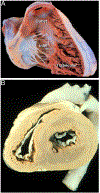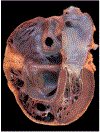The Right Ventricle: From Embryologic Development to RV Failure
- PMID: 36149589
- PMCID: PMC9818027
- DOI: 10.1007/s11897-022-00572-z
The Right Ventricle: From Embryologic Development to RV Failure
Abstract
Purpose of review: The right ventricle (RV) and left ventricle (LV) have different developmental origins, which likely plays a role in their chamber-specific response to physiological and pathological stress. RV dysfunction is encountered frequently in patients with congenital heart disease (CHD) and right heart abnormalities emerge from different causes than increased afterload alone as is observed in RV dysfunction due to pulmonary hypertension (PH). In this review, we describe the developmental, structural, and functional differences between ventricles while highlighting emerging therapies for RV dysfunction.
Recent findings: There are new insights into the role of fibrosis, inflammation, myocyte contraction, and mitochondrial dynamics in the pathogenesis of RV dysfunction. We discuss the current state of therapies that may potentially improve RV function in both experimental and clinical trials. A clearer understanding of the differences in molecular alterations in the RV compared to the LV may allow for the development of better therapies that treat RV dysfunction.
Keywords: Adult congenital heart disease; Congenital heart disease; Left ventricle; Pulmonary hypertension; Right ventricle; Right ventricular failure.
© 2022. This is a U.S. Government work and not under copyright protection in the US; foreign copyright protection may apply.
Conflict of interest statement
Figures




Similar articles
-
Novel therapeutic approaches to preserve the right ventricle.Curr Heart Fail Rep. 2013 Mar;10(1):12-7. doi: 10.1007/s11897-012-0119-3. Curr Heart Fail Rep. 2013. PMID: 23065390 Free PMC article. Review.
-
Right Ventricular Fibrosis.Circulation. 2019 Jan 8;139(2):269-285. doi: 10.1161/CIRCULATIONAHA.118.035326. Circulation. 2019. PMID: 30615500
-
Pulmonary vascular mechanical consequences of ischemic heart failure and implications for right ventricular function.Am J Physiol Heart Circ Physiol. 2019 May 1;316(5):H1167-H1177. doi: 10.1152/ajpheart.00319.2018. Epub 2019 Feb 15. Am J Physiol Heart Circ Physiol. 2019. PMID: 30767670 Free PMC article.
-
Clinical Determinants and Prognostic Implications of Right Ventricular Dysfunction in Pulmonary Hypertension Caused by Chronic Lung Disease.J Am Heart Assoc. 2019 Jan 22;8(2):e011464. doi: 10.1161/JAHA.118.011464. J Am Heart Assoc. 2019. PMID: 30646788 Free PMC article.
-
The Right Heart in Congenital Heart Disease.Curr Heart Fail Rep. 2023 Dec;20(6):471-483. doi: 10.1007/s11897-023-00629-7. Epub 2023 Sep 29. Curr Heart Fail Rep. 2023. PMID: 37773427 Review.
Cited by
-
A Narrative Review of the Clinical Applications of Echocardiography in Right Heart Failure.J Clin Med. 2025 Aug 5;14(15):5505. doi: 10.3390/jcm14155505. J Clin Med. 2025. PMID: 40807125 Free PMC article. Review.
-
An Undifferentiated Primary Mediastinal Carcinoma Compressing the Main Pulmonary Artery: A Rare Cause of Right Ventricular Strain.Cureus. 2024 Jan 23;16(1):e52789. doi: 10.7759/cureus.52789. eCollection 2024 Jan. Cureus. 2024. PMID: 38268992 Free PMC article.
-
Unlocking the Potential: Angiotensin Receptor Neprilysin and Sodium Glucose Co-Transporter 2 Inhibitors for Right Ventricle Dysfunction in Heart Failure.Medicina (Kaunas). 2024 Jul 9;60(7):1112. doi: 10.3390/medicina60071112. Medicina (Kaunas). 2024. PMID: 39064541 Free PMC article. Review.
-
Assessment of Right Ventricular Function-a State of the Art.Curr Heart Fail Rep. 2023 Jun;20(3):194-207. doi: 10.1007/s11897-023-00600-6. Epub 2023 Jun 5. Curr Heart Fail Rep. 2023. PMID: 37271771 Free PMC article. Review.
-
Association of Male Sex With Worse Right Ventricular Function and Survival in Pulmonary Hypertension in the Redefining Pulmonary Hypertension Through Pulmonary Vascular Disease Phenomics Cohort.CHEST Pulm. 2024 Sep;2(3):100046. doi: 10.1016/j.chpulm.2024.100046. Epub 2024 Mar 11. CHEST Pulm. 2024. PMID: 39524046 Free PMC article.
References
-
-
Sanz J, Sánchez-Quintana D, Bossone E, Bogaard HJ, Naeije R. Anatomy, function, and dysfunction of the right ventricle: JACC state-of-the-art review. J Am Coll Cardiol. 2019;73(12):1463–82.
In this article, the authors provide a contemporaneous review of right ventricular anatomy, physiology, and hemodynamics while highlighting how the right ventricle plays an essential role in determining prognosis in nearly all cardiovascular disorders.
-
-
-
Friedberg MK, Redington AN. Right versus left ventricular failure: differences, similarities, and interactions. Circulation. 2014;129(9):1033–44.
The authors emphasize the differences between the left and right ventricle but also appropriately acknowledge that both ventricles share similar features in adaptation when faced with pressure or volume overloading conditions.
-
Publication types
MeSH terms
Grants and funding
LinkOut - more resources
Full Text Sources
Medical
Research Materials

